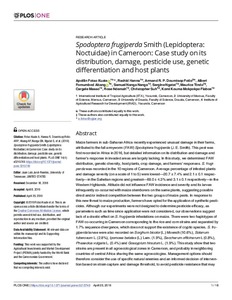| dc.contributor.author | Fotso Kuate, A. |
| dc.contributor.author | Hanna, R. |
| dc.contributor.author | Doumtsop Fotio, A.R.P. |
| dc.contributor.author | Abang, A.F. |
| dc.contributor.author | Nanga, S.N. |
| dc.contributor.author | Ngatat, S. |
| dc.contributor.author | Tindo, M. |
| dc.contributor.author | Masso, C. |
| dc.contributor.author | Ndemah, R. |
| dc.contributor.author | Suh, C. |
| dc.contributor.author | Fiaboe, K. |
| dc.date.accessioned | 2019-12-04T11:33:46Z |
| dc.date.available | 2019-12-04T11:33:46Z |
| dc.date.issued | 2019-04-08 |
| dc.identifier.citation | Fotso Kuate, A., Hanna, R., Doumtsop, A.F., Abang, A.F., Nanga, S.N., Ngatat, S., ... & Fiaboe, K. (2019). Spodoptera frugiperda Smith (Lepidoptera: Noctuidae) in Cameroon: case study on its distribution, damage, pesticide use, genetic differentiation and host plants. PLOS ONE, 14(4): e0215749, 1-18. |
| dc.identifier.issn | 1932-6203 |
| dc.identifier.uri | https://hdl.handle.net/20.500.12478/5805 |
| dc.description | Open Access Journal |
| dc.description.abstract | Maize farmers in sub-Saharan Africa recently experienced unusual damage in their farms, attributed to the fall armyworm (FAW) Spodoptera frugiperda (J. E. Smith). This pest was first recorded in Africa in 2016, but detailed information on its distribution and damage and farmer's response in invaded areas are largely lacking. In this study, we determined FAW distribution, genetic diversity, host plants, crop damage, and farmers' responses. S. frugiperda was recorded in the 10 regions of Cameroon. Average percentage of infested plants and damage severity (on a scale of 1 to 5) were lowest-20.7 ± 7.4% and 2.1 ± 0.1 respectively-in the Sahelian regions and greatest-69.0 ± 4.3% and 3.1 ± 0.1 respectively-in the Western Highlands. Altitude did not influence FAW incidence and severity and its larvae infrequently co-occurred with maize stemborers on the same plants, suggesting possible direct and/or indirect competition between the two groups of maize pests. In response to this new threat to maize production, farmers have opted for the application of synthetic pesticides. Although our experiments were not designed to determine pesticide efficacy, as parameters such as time since application were not considered, our observations suggest lack of a drastic effect on S. frugiperda infestations on maize. There were two haplotypes of FAW co-occurring in Cameroon corresponding to the rice and corn strains and separated by 1.7% sequence divergence, which does not support the existence of cryptic species. S. frugiperda larvae were also recorded on Sorghum bicolor (L.) Moench (10.6%), Solanum tuberosum L. (2.8%), Ipomoea batatas (L.) Lam. (1.9%), Saccharum officinarum L (0.8%), Phaseolus vulgaris L. (0.4%) and Gossypium hirsutum L. (1.9%). This study show that two strains are present in all agroecological zones in Cameroon, and probably in neighboring countries of central Africa sharing the same agroecologies. Management options should therefore consider the use of specific natural enemies and an informed decision of intervention based on strain capture and damage threshold, to avoid pesticide resistance that may arise from inadequate use of chemicals. Further studies should also be undertaken to assess the response of the two S. frugiperda strains to biopesticides and botanical insecticides. |
| dc.description.sponsorship | World Bank |
| dc.description.sponsorship | Governmet of Cameroon |
| dc.format.extent | 1-18 |
| dc.language.iso | en |
| dc.rights | CC-BY-4.0 |
| dc.subject | Cameroon |
| dc.subject | Maize |
| dc.subject | Cropping Systems |
| dc.subject | Data Collection |
| dc.subject | Farm Management |
| dc.title | Spodoptera frugiperda Smith (Lepidoptera: Noctuidae) in Cameroon: case study on its distribution, damage, pesticide use, genetic differentiation and host plants |
| dc.type | Journal Article |
| dc.description.version | Peer Review |
| cg.contributor.affiliation | International Institute of Tropical Agriculture |
| cg.contributor.affiliation | University of Maroua |
| cg.contributor.affiliation | University of Douala |
| cg.contributor.affiliation | Institute of Agricultural Research for Development |
| cg.coverage.region | Africa |
| cg.coverage.region | Central Africa |
| cg.coverage.country | Cameroon |
| cg.creator.identifier | Fotso Kuate, A.: 0000-0002-5247-7519 |
| cg.creator.identifier | Rachid Hanna: 0000-0002-5715-0144 |
| cg.creator.identifier | Cargele Masso: 0000-0002-3980-6832 |
| cg.researchtheme | NATURAL RESOURCE MANAGEMENT |
| cg.researchtheme | PLANT PRODUCTION & HEALTH |
| cg.isijournal | ISI Journal |
| cg.authorship.types | CGIAR and developing country institute |
| cg.iitasubject | Natural Resource Management |
| cg.iitasubject | Plant Health |
| cg.iitasubject | Plant Production |
| cg.journal | PLOS ONE |
| cg.howpublished | Formally Published |
| cg.accessibilitystatus | Open Access |
| local.dspaceid | 105200 |
| cg.targetaudience | Scientists |
| cg.identifier.doi | https://dx.doi.org/10.1371/journal.pone.0215749 |

